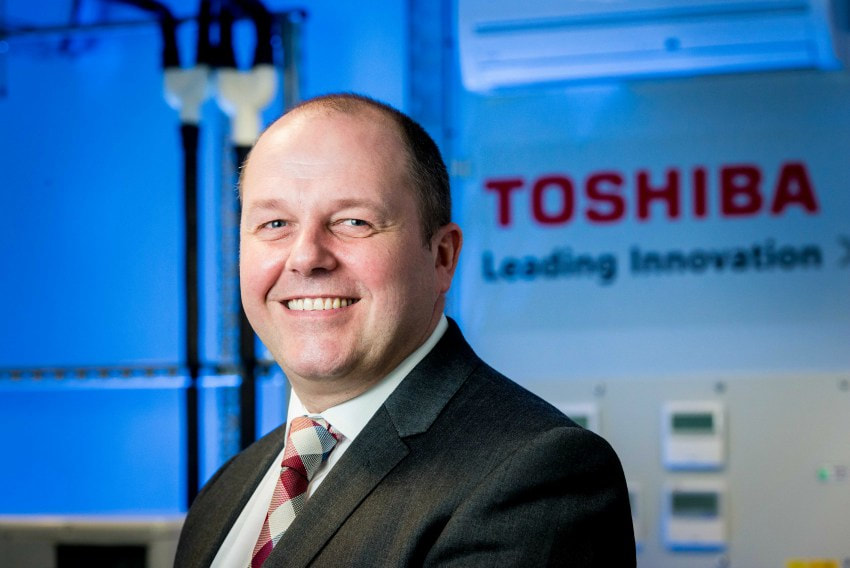19 April 2018
|
| Toshiba is switching its full residential and light commercial air conditioning ranges for the UK to R32 refrigerant. David Dunn, Managing Director of Toshiba Air Conditioning in the UK, announced an extended and re-engineered line-up of single and multi split systems for residential and Digital Inverter and Super Digital Inverter light commercial products using the A2L refrigerant. Other than VRF equipment, Toshiba says it will not be shipping any further R410A units where there is an R32 alternative to replace existing UK stock. |
The announcement comes against the backdrop of rapidly rising prices and supply issues surrounding R410A. Lower GWP R32 is seen by an increasing number of manufacturers as the only current viable alternative for split systems.
There is no similar alternative for the larger VRF systems and, with Toshiba saying that technology accounts for almost 50% of its sales in the UK, the move is also designed to ease the demand for R410A.
David Dunn said: "R32 is still classed as a transitional refrigerant but the fact is there is no real alternative available. We always listen to our customers and they are now telling us they want R32.''
Training
That represents a significant change within 12 months. At a Toshiba customer event last spring, just 13% said they wanted R32 systems to be made available. A recent survey of around 800 customers showed that figure now above 70%, with cost the main driver.
Toshiba is investing in making training more accessible and affordable to customers for the 'mildly flammable' refrigerant. It is working with a number of training companies to offer subsidised courses which could effectively be free of charge if used in conjunction with Toshiba's rewards scheme.
David Dunn said he was committed to ensuring that customers were fully aware of the implications of using R32 and had all the relevant information, adding: "We want to make sure we’re doing it right. If people are aware of the risks and know the correct procedures, they can make sure they do it right.”
There is no similar alternative for the larger VRF systems and, with Toshiba saying that technology accounts for almost 50% of its sales in the UK, the move is also designed to ease the demand for R410A.
David Dunn said: "R32 is still classed as a transitional refrigerant but the fact is there is no real alternative available. We always listen to our customers and they are now telling us they want R32.''
Training
That represents a significant change within 12 months. At a Toshiba customer event last spring, just 13% said they wanted R32 systems to be made available. A recent survey of around 800 customers showed that figure now above 70%, with cost the main driver.
Toshiba is investing in making training more accessible and affordable to customers for the 'mildly flammable' refrigerant. It is working with a number of training companies to offer subsidised courses which could effectively be free of charge if used in conjunction with Toshiba's rewards scheme.
David Dunn said he was committed to ensuring that customers were fully aware of the implications of using R32 and had all the relevant information, adding: "We want to make sure we’re doing it right. If people are aware of the risks and know the correct procedures, they can make sure they do it right.”
| Toshiba says a number of key improvements have been made to the re-engineered systems, including cooling for the required steel circuit board enclosure, leak detection and energy monitoring. A new fan blade design claims a 30% improvement on airflow and a redesigned heat exchanger with increased surface area is said to achieve 30% higher efficiency. Toshiba claims 'best in class' SEER of up 9.4 and SCOP of up to 5.5, with the range able to operate to -27ºC in heating mode and up to +52ºC in cooling. |
2020 vision for VRF
Toshiba is working to develop new VRF technology that can operate without high GWP refrigerant.
David Dunn said: “There are two options. Either a new refrigerant that is safer or a completely new technology. One of those two has to happen and to happen quite quickly.
"From the information we have from Japan, there are two potential ways forward that they are working on. Once they’ve built and tested them, then we’ll decide which is the way forward and we will be launching a new VRF, probably 2020 into 2021.”
Toshiba is working to develop new VRF technology that can operate without high GWP refrigerant.
David Dunn said: “There are two options. Either a new refrigerant that is safer or a completely new technology. One of those two has to happen and to happen quite quickly.
"From the information we have from Japan, there are two potential ways forward that they are working on. Once they’ve built and tested them, then we’ll decide which is the way forward and we will be launching a new VRF, probably 2020 into 2021.”
Content continues after advertisements









